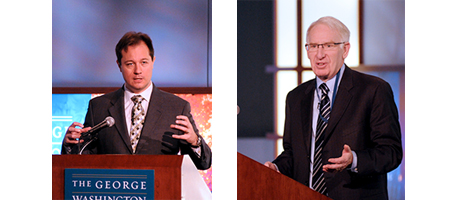If you want to assess a nation’s health care system, take a good look at its emergency medicine departments, said the speakers at Emergency Care GPS, a recent seminar at GW’s Jack Morton Auditorium.
Under this lens, the entire system’s strengths and weaknesses are magnified.
“The emergency department is a stage on which all the weaknesses of the U.S health care system play,” said Robert Shesser, chair of the Department of Emergency Medicine in GW’s School of Medicine and Health Sciences.
The seminar was the first in a series on emergency care and public health preparedness in American society hosted by the emergency medicine department, the Department of Health Policy in the School of Public Health and Health Services and the Department of Engineering Management and Systems Engineering in the School of Engineering and Applied Science.
Led by Jesse Pines, director of the Center for Health Care Quality and associate professor of medicine, the inaugural seminar focused on debunking myths about American emergency departments. Four international experts also provided participants with a global perspective on trends in emergency department utilization.
The first myth addressed by Dr. Shesser was the common sentiment that emergency departments are overcrowded because a large number of patients use them for primary care. In reality, he said, the reason for overcrowding “comes down to some fundamental operational issues” like a decrease in the number of hospitals, a high prevalence of chronic disease and “asynchrony between the admission wave and the discharge wave.”
Dr. Shesser next questioned the idea that emergency departments are inherently expensive alternatives to other outpatient settings. While the average emergency department visit payment in 2008 was $922 and the average office visit payment was only $199, he said it’s important to recognize that the latter number doesn’t account for any ancillary payments such as lab tests and x-rays. In all, emergency department care represents only 2 percent of total U.S. health care costs.
Another myth addressed was emergency department patients being orphans of the system and lacking long-term relationships with outside doctors. Depending on where the hospital is located, patients may or may not have additional providers, Dr. Shesser said. An emergency department’s patients tend to reflect the demographic of the community in which it’s located.
Dr. Shesser also noted that hospitalization guidelines aren’t as clear cut as most people would like to believe. Admittance to an emergency department can be arbitrary, often influenced by how a physician assesses a patient and even how long that physician has been practicing.
Finally, the idea that most hospitals can treat all types of emergent patients is unfortunately not always true. There is “an extreme lack of coordination” when it comes to incorporating specialty care into emergency departments, Dr. Shesser said.
After Dr. Shesser’s presentation, four experts from around the world discussed international emergency medicine. Philip Anderson, attending physician at the Department of Emergency Medicine at Beth Israel Deaconess Medical Center at Harvard University, spoke about the system in Denmark where he has lived and studied.
The Danish system, which is currently undergoing a major transformation, “has the potential to result in a truly world-class model for how emergency care can be delivered,” said Dr. Anderson. In Denmark, the emergency department is strongly primary-care oriented, has limited malpractice liability, uses a telephone triage system to direct patients to the right hospital, and, unlike many of its international counterparts, doesn’t struggle with overcrowding.
Next, Michael Schull, director of the Division of Emergency Medicine at the University of Toronto, delivered a webcast presentation on the Canadian publicly funded health care system, which has no private hospitals. Dr. Shull addressed some of Canada’s biggest health care challenges, including wait times that fall behind most other developed countries for same-day or next-day access.
The third panelist, Eric Revue, an emergency physician toxicologist at Victor Jousselin’s Hospital in France, provided an overview of the French emergency medicine system, which, as in Demark, triages patients via a telephone system. French citizens have universal insurance coverage and by law cannot be denied care in emergency departments on the basis of acute symptoms or vital signs.
Dr. Revue said France too suffers from emergency department overcrowding, and the country’s biggest concern is the rising number of non-urgent phone calls to the triage center.
Finally, Lit-Sin Quek, head of the Emergency Medicine Department at Alexandra Hospital in Singapore, said his country is struggling with “the diseases of affluence,” as the result of the nation’s rapid economic growth.
Dr. Quek said while Singapore is good at providing episodic care, it struggles to provide quality long-term or preventive care. The nation is embarking on new initiatives that emphasize wellness, not disease.
“There is a lot of variability across countries in terms of how emergency care is delivered, and I think it’s important to look to each other as we’re trying to remake our emergency care systems,” said Dr. Pines.


